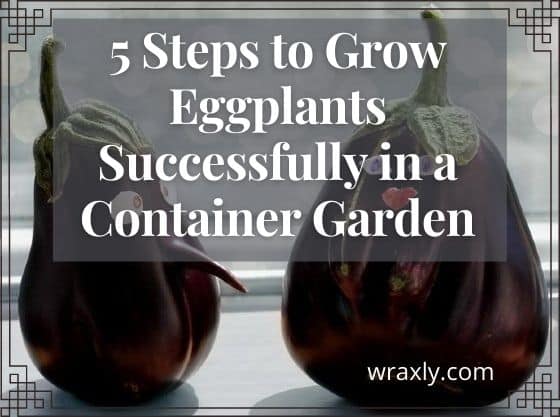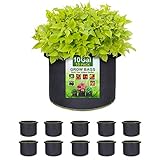A summertime harvest of eggplants provides tasty and tender fruits that you can incorporate into your cooking. If you want to enjoy such a harvest, you need to learn how to grow eggplants successfully. As you’ll soon see, growing these plants in container gardens is one of the best approaches. This article will teach you all that and more by walking you through five easy steps to grow eggplants in containers:
- Use the Best Container for Your Eggplant
- Find Soil that Your Eggplant will Love
- Plant Eggplant at the Right Time of Year
- Give Your Eggplant Water and Nutrients
- Know When and How to Harvest Eggplant

Use the Best Container for Your Eggplant
No matter what plants you grow, an impressive container garden begins with high-quality containers. But not all containers will give you the same chance for success, which means you need to know what to look for when selecting one. In general, the best containers are ones that have:
- Great drainage for water
- Plenty of space for root development
- Durable, long-lasting materials
Common Container Materials
A few container materials are useful in many situations, including when growing eggplant. Each of the ones below is readily available and offer a unique set of pros and cons:
- Clay
- Ceramic
- Stone
- Plastic
- Fabric
You can take time to learn about and evaluate each of those options. If you do, you may quickly come to the realization that there is one option that stands out from the rest.

Benefits of Fabric Grow Bags
Fabric grows bags have many advantages that allow them to outperform other container options. Here are a few of the primary benefits of using a fabric grow bag:
- Excellent drainage
- Continuous airflow
- Soil temperature moderation
Those benefits arise from the fact that fabric grow bags consist of a porous material. That permeability makes for incredibly efficient drainage, preventing your soil form becoming waterlogged. The breathability of fabric grow bags also allows for better airflow around the roots, which prevents drastic soil temperature shifts that can shock your plants.
Recommended Grow Bags for Growing Eggplant
| Image | Title | Prime | Buy |
|---|---|---|---|
 Top
Top
Top
Top
Top
Top
Top
Top | Gardzen 10-Pack 5 Gallon Grow Bags, Aeration Fabric Pots with Handles | PrimeEligible | Check Price on Amazon |
Top | Wraxly Fabric Grow Bags - 7 Gallon Colorful Two-Tone Planter Pots. Best Gardening Gift for Plant Lovers! [5-Pack of Assorted Colors - Plus Black Bonus Bag!] | PrimeEligible | Check My Price on Amazon |
 Top
Top
Top
Top
Top
Top
Top
Top | VIVOSUN 10-Pack 15 Gallon Grow Bag, Reinforced Planter Fabric Pot for Gardening | PrimeEligible | Check Price on Amazon |
 Top
Top
Top
Top
Top
Top
Top
Top | SunArea 10-Pack 10 Gallon Grow Bags, Thickened Nonwoven Aeration Fabric Pots with Reinforced Handles, Heavy Duty Plant Grow Bag for Gardening | PrimeEligible | Check Price on Amazon |
 Top
Top | VIVOSUN 5-Pack 20 Gallon Plant Grow Bags, Heavy Duty Thickened Nonwoven Fabric Pots with Handles | PrimeEligible | Check Price on Amazon |
 Top
Top | JERIA 12-Pack 5 Gallon, Vegetable/Flower/Plant Grow Bags, Aeration Fabric Pots with Handles (Black), Come with 12 Pcs Plant Labels | PrimeEligible | Check Price on Amazon |
Use a Dark Container for Eggplant
Eggplants need warm weather to grow and produce their fruits. Often, the soil temperature is the main factor in how successful your plant will be. One helpful way to keep your soil warm is to use a container that has a dark color.
Dark colors absorb more light than other hues. When you have a container that is black, blue, or some other dark shade, it will make better use of the sunlight that touches it.
Rather than reflecting that light, a dark container will take it in. That heat absorption makes the soil a bit warmer than it would normally be, which is a better setting for eggplant root development.
Place Your Container in a Sunny Location
Once you find the right container, it’s time to decide where to put it. To grow an eggplant, you’ll need to locate it in an area that receives full sunlight. Look for a place that gets six hours of sun exposure or more.
Beyond finding adequate sunlight, you should also choose a location that is easy to access. That way, it will be easy to access your eggplant to give it the care it needs and harvest its fruits when the time is right.
Find Soil that Your Eggplant will Love
Once you’ve found a container for your eggplant, you need to fill it with soil. The best soil to use when growing eggplant is:
- Sandy loam
- Slightly acidic
- Well-draining
It’s also helpful to add amendments to the soil you use. Materials like compost are excellent for adding organic nutrients that your eggplant can consume to aid its growth. You’ll also need to find ways to help the soil remain moist but not too wet.
Maintain Soil Moisture with Mulch
Mulching is another standard gardening chore that is especially vital for eggplants. Eggplants prefer to live in full sun locations, but they also must have soil that is consistently moist.
When your soil is unprotected and sits in the kind of full sun setting an eggplant needs, it can easily become dry during a hot spell. That is why you should always add a layer of mulch on top of the soil in your container.
A two-to-three-inch layer of organic mulch will help the soil retain moisture and a reasonable temperature. It will also break down over time to add more nutrients to the soil.
FURTHER READING
- How to Make DIY Grow Bags
- How to Grow Sunflowers in a Pot
- Growing Lemon Trees in Pots
- How to Start a Container Garden
Plant Eggplant at the Right Time of Year
One fact that you need to know about planting and growing eggplant is that this plant only survives during warm weather seasons. Don’t allow your eggplant to grow in soil that is below 50 degrees Fahrenheit.
Likewise, you should know that eggplant only grows in a specific range of hardiness zones. In zones five through nine, it grows as an annual. In zones 10, 11, and 12, it is a perennial plant.
If you garden in the colder part of that range, wait until late spring to let your eggplant grow outside. The chances are, you’ll need to start your seeds indoors before the spring arrives to give your eggplant enough time to grow over the coming season.
How to Plant Eggplant in Containers
Timing is crucial when planting eggplant, and so is technique. Let’s assume that you’ll be starting with seeds and that you live in a region where the winters are too cold for an eggplant to grow outdoors. In those cases, you should start your seeds about six to ten weeks before the winter’s last frost. At that time, here are the steps to follow:
- Soak seeds in water overnight
- Fill a seed tray with nutrient-rich soil
- Insert your seeds about a quarter-inch into the soil
- Provide water weekly
- Transplant seedlings into your chosen container after about two weeks
- Transfer your container outdoors after the last frost
Eggplant often needs a relatively long growing season. That is why it is essential to start your seeds early and indoors where it is warm enough for them to survive. During germination, keep your seeds in an area that is at least 60 degrees Fahrenheit or more.
Give Your Eggplant Water and Nutrients
After successfully planting your eggplant in a container, it is time to take on the ongoing maintenance that this plant will need. A regular supply of water and nutrients is what an eggplant needs to exhibit its most vigorous growth and produce an admirable harvest.

How to Water Eggplant in Containers
Give your eggplant water once per week. When you do, it is best to soak the root ball all at once rather than providing water in small amounts. Overall, you should give your eggplant about one inch of water weekly.
Fertilizing Eggplant in Containers
Along with regular watering, you’ll need to provide enough fertilizer for your eggplant as well. In general, it is best to apply fertilizer twice during the growing season.
The first application should take place just after planting. The second should happen in the summer, just before the fruits develop. When you fertilize, use a mix that has equal amounts of nitrogen, phosphorus, and potassium.
- Proven protein & plant based formula for fast-acting results and keeps feeding for 6-8 weeks
- Produces excellent results for tomatoes, fruit, vegetable, herbs, and berries
- Ideal for use indoors and outdoors across all regions of the United States
- Balanced Triple Play 8-8-8 formula: 8% Nitrogen for plant growth; 8% Phosphorus for fruiting and blooms; 8% Potassium for strong roots
- Covers up to 250 square feet. Packaged in a resealable pouch for convenient storage when not in use
Prices pulled from the Amazon Product Advertising API on:
Product prices and availability are accurate as of the date/time indicated and are subject to change. Any price and availability information displayed on [relevant Amazon Site(s), as applicable] at the time of purchase will apply to the purchase of this product.
Know When and How to Harvest Eggplant
With most of the hard work of planting and caring for your eggplant out of the way, it is time for harvest. As was the case with planting, harvesting an eggplant is a matter of timing and technique.
The Best Time to Harvest Eggplant
Ironically, it would help if you did not allow your eggplant fruit to become fully mature. Eggplant fruits that are not fully mature often have a better flavor and texture.
In many instances, it will take about 100 or more days for the harvest to arrive when you start an eggplant from seed. However, this will vary based on your region, the variety of eggplant you grow, and how well you care for your eggplant.
Another benefit of harvesting your eggplant somewhat early is that it will stimulate the plant to produce more fruits. Once the fruits begin to develop, removing them from the plant correctly is the best way to encourage a large harvest.

How to Harvest Eggplant
Once you notice an eggplant that is ready for harvest, take a sharp pair of shears to remove it. To do so, find an eggplant with smooth glossy skin, then locate the stem. Follow the stem about an inch up from the fruit and make your cut there.
The sharper your tools are, the easier it will be to cut through the stem of the eggplant. Cutting in the right location will make it easier for your eggplant to recover from that wound and begin sending its growing energy to new fruits.
Growing Eggplants Successfully in a Container Garden: Final Thoughts
Growing eggplant successfully in a container garden is not as difficult as it might seem at first. To incorporate fresh, home-grown eggplant into your favorite dishes, all you need to do is follow the five steps above.

John Haryasz is a freelance writer and landscape designer. In the field of landscape architecture, he has contributed to many successful design projects throughout the country. As a writer, John specializes in creating captivating and informative web content. Through that work, he aims to share his design knowledge and promote engagement with the outdoor world.


![How to Water Indoor Plants [Plant Care 101]](https://wraxly.com/wp-content/uploads/2021/03/How-to-Water-Indoor-Plants-Plant-Care-101-1200-1024x576.webp)

![Growing Plants from Cuttings [A Simple Guide]](https://wraxly.com/wp-content/uploads/2021/03/Growing-Plants-from-Cuttings-A-Simple-Guide-1200-1024x576.webp)
